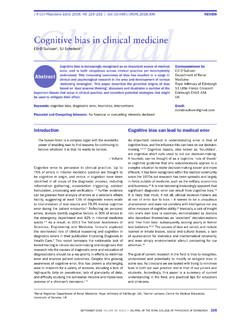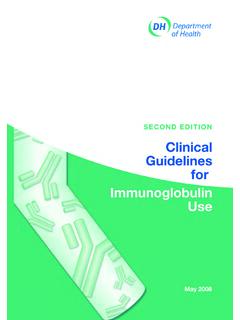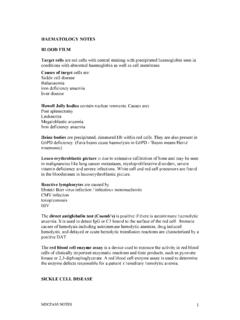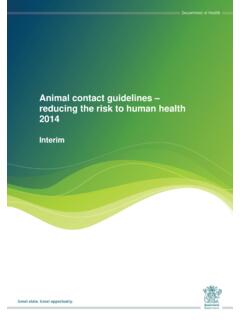Transcription of ACUTE KIDNEY INJURY
1 ACUTE KIDNEY INJURYM obile Application ContentKidney Care1 Risk FactorsRisk of AKI = Baseline risk x ACUTE illness risk Baseline risk may be increased by a history of: Chronic KIDNEY Disease - eGFR <60 ml/ m2 and/or history of proteinuria Age >75 years Heart failure Liver disease Cardiovascular disease (previous MI, stroke, PVD) Diabetes mellitus Recent use of nephrotoxins, non-steroidal anti-inflammatory drugs, angiotensin converting enzyme inhibitors, angiotensin receptor blockers, gentamicin, iodinated contrastAcute illness risk may be increased by: Hypotension(Consider relative hypotension in people with a history of hypertension as this will result in renal hypoperfusion) Sepsis High Early Warning Score HypovolaemiaPreventionAim to: Identify patients at risk (see AKI risk factors) Optimise volume status Treat sepsis promptly Avoid nephrotoxins Review medications, adjust drug doses, withhold antihypertensives if hypotensive Reduce risk of contrast-induced AKI: The risk of contrast-induced AKI is small in the general population Patients at high risk are the acutely ill, with AKI/CKD, sepsis and hypovolaemia Consult the Prevention of Contrast-Induced ACUTE KIDNEY INJURY guideline at and ClassificationAcute KIDNEY INJURY is defined as.
2 Increase in serum creatinine of 26 mol/L within 48 hoursORan increase in serum creatinine times above baseline value within 1 weekORurine output of < ml/kg/hr for > 6 consecutive hoursIf a baseline serum creatinine value is not available within 3 months and AKI is suspected: repeat serum creatinine within 24 hours a baseline serum creatinine value can be estimated from the nadir serum creatinine value if patient recovers from AKIP atients that meet the definition for AKI can be staged according to whichever criteria (serum creatinine or urine output) gives them the highest stage. KDIGO staging system for ACUTE KIDNEY INJURY :StageSerum creatinineUrine output1rise 26 mol/L within 48 hrorrise to X baseline SCr< mL/kg/hr for >6consecutive hr2rise 2 to X baseline SCr< mL/kg/hr for >12 hr3rrise 3 X baseline SCrorrise 354 mol/LorCommenced on renal replacement therapy (RRT) irrespective of stage< mL/kg/hr for >24 hroranuria for 12 hrACUTE KIDNEY INJURY RecognitionACUTE KIDNEY INJURY Assessment3 Typical vasculitic rashRed eye may occur in vasculitisACUTE KIDNEY INJURY Assessment2 HistoryFocus history on ascertaining the main causes of AKI (many patients have more than one cause of AKI):Common causes Sepsis Hypoperfusion (hypotension, hypovolaemia, etc.)
3 Medications ObstructionLess common causes(consider these if the common causes listed above are not obvious) Intrinsic renal diseaseso Glomerulonephritiso Vasculitiso Interstitial nephritis o MyelomaRemember that there are many causes of AKI:Pre-renal (functional) Hypovolemia, bleeding, gastrointestinal losses Sepsis Cardiac arrhythmias Myocardial infarction Renal artery stenosisIntrinsic renal (damage) Prolonged hypoperfusion causing tubular INJURY Infiltrative disease, myeloma Nephrotoxins Glomerulonephritis Interstitial nephritis RhabdomyolysisPost-renal (functional) Renal stone disease Pelvic masses, cervical cancer Prostatic hypertrophy / cancer Urethral strictureClues from the historySepsis Fever Cough with sputum Vomiting and diarrhoea Dysuria Urinary catheter Immunosupression(can predispose and also prevent rise in white cell count masking sepsis) Hypoperfusion Vomiting and/or diarrhoea Haemorrhage Cardiac failure ( ACUTE or chronic)
4 Cardiac arrhythmias Diuretics (over diuresis)Medications Non-steroidal anti-inflammatory drugs(NSAIDs are nephrotoxic and can also cause interstitial nephritis) Angiotensin-converting enzyme inhibitors(ACEi reduces renal blood flow) Angiotensin receptor blockers(ARBs reduces renal blood flow) Gentamicin and vancomycin(high levels of aminoglycosides are nephrotoxic) Iodinated contrast agents (contrast-induced AKI) Any new medication(some drugs can cause interstitial nephritis, NSAIDs, proton pump inhibitors and antibiotics) Herbal remedies(may contain nephrotoxic compounds) Over the counter medicationsClues from the history (cont.)Obstruction History of KIDNEY stones Prostatic symptoms(prostatic hypertrophy or malignancy) Known single KIDNEY (obstruction of one ureter will cause AKI) Pelvic malignancyIntrinsic renal disease Constitutional symptoms(fever and weight loss are non-specific but are features of vasculitis) Joint pains (vasculitis) Rashes(purpuric rashes or nodules may be a sign of vasculitis) Nasal stuffiness(sinus involvement in ANCA-associated vasculitis, granulomatosis with polyangiitis) Haemoptysis (vasculitis) Red eye (uveitis in vasculitis) Back pain(bone pain may be a sign of myeloma the lower back is a common site) Falls/immobility (rhabdomyolysis) Neuropathies (vasculitis)
5 ExaminationAim to identify clues as to the cause, assess volume status and identify any the cause:Pre-renal Volume status examination Evidence of sepsis, fever, respiratory signs, surgical site, red swollen joints, cellulitis, indwelling urinary catheters, cannulae Evidence of haemorrhage, haematemesis, melaenaIntrinsic Volume status examination Rash (vasculitis, interstitial nephritis) Red eye (vasculitis) Red swollen joints (vasculitis) Swollen limb (rhabdomyolysis) ACUTE KIDNEY INJURY AssessmentACUTE KIDNEY INJURY Response54 Examination (cont.)Post-renal Tense ascites (intra-abdominal hypertension) Palpable bladder Large prostateFluid status Capillary refill (<3 s) Pulse rate (tachycardia may be masked by beta blockers) Blood pressure (lying and standing if patient able to stand safely) Skin turgor (over clavicle) Jugular venous pressure Oedema (peripheral and pulmonary) Fluid balance charts Daily weights (trends in body weight are a sensitive indicator of volume status)Complications Hyperkalaemia (potassium > mmol/L) Acidosis ACUTE confusion (uraemic encephalopathy) Pulmonary oedema Pericarditis (pericardial friction rub)InvestigationAims to identify the cause and identify patients: Biochemistry profile.
6 O Ureao Liver function testso Electrolyteso Glucoseo Creatinineo Bone profileo Bicarbonate Full blood counto Look for evidence of haemorrhage and sepsiso Low platelets may occur with sepsis or haemolytic uraemic syndrome /thrombotic thrombocytopenic purpura Urinalysiso Blood and/or protein is abnormal o Urinary tract infection and vasculitis must be consideredConsider: Cultures:o bloodo urineo wound C-reactive protein (CRP) Lactate (surrogate marker of shock and hypoperfusion) Venous or arterial blood gas Coagulation screen Creatine kinase (rhabdomyolysis) Lactate dehydrogenase (LDH) Blood film (HUS/TTP) Serum and urine electrophoresis (myeloma) Serum free light chains (myeloma) Anti-glomerular basement membrane antibodies (Goodpastures disease)Investigation (cont.)
7 Consider: Urine Bence-Jones protein (myeloma) Anti-neutrophil cytoplasmic antibody (ANCA; vasculitis) Anti-nuclear antibody (ds DNA specific for SLE) Complement (C3 and 4) Hepatitis B and C serology Renal tract ultrasound (if no obvious precipitating cause and AKI not responding to supportive measures to check for renal anatomy and exclude obstruction) CXR (infection, pulmonary oedema, pulmonary haemorrhage) ECG (hyperkalaemia, pericarditis, arrhythmia, ischaemia)ManagementTreatment is initially supportive but ultimately dependent upon the underlying cause. It is important to reduce both the severity and duration of AKI as this predicts progression to chronic KIDNEY disease (CKD).
8 All patients:Immediate assessment and response - ABCDE approach1. Rapid correction of hypovolaemia and restoration of haemodynamic status 500 ml (250 ml if patient has a history of cardiac failure) of a balanced crystalloid stat ( Hartmann s solution) rapidly If hyperkalaemia is present (K+> mmol/L) in the setting of oliguric AKI or rhabdomyolysis sodium chloride is preferred initially Conversion to a balanced crystalloid can be considered once potassium levels are known and good urine output established. Assess clinical response to fluid in terms of:o capillary refill timeo pulse (reduction in pulse if tachycardic)o jugular venous pressure (rise in JVP)o blood pressure (rise in BP)o pulmonary oedema o urine output (increasing if oliguric) If no clinical response and no pulmonary oedema administer further 500 ml of crystalloid, reassess clinically and discuss with senior member of team If clinical response to fluid bolus continue with IV fluids and discuss further fluid therapy management plan with senior member of team If the patient develops oliguric AKI despite adequate volume resuscitation consider the patient as having volume unresponsive AKI.
9 Further excessive fluid resuscitation may result in pulmonary oedema. If the patient has volume unresponsive AKI continue with IV fluid cautiously, matching urine output and monitoring for signs of respiratory distress (rising respiratory rate, pulmonary oedema or falling oxygen saturations) If the patient remains hypotensive despite volume resuscitation, vasopressor support may be requiredPulmonary oedemaPneumoniaACUTE KIDNEY INJURY ResponseACUTE KIDNEY INJURY Response6 Management (cont.)2. Prompt treatment of sepsis ideally following appropriate cultures3. Avoid nephrotoxins Aminoglycosides Amphotericin Iodinated contrast NSAIDs4. Adjust dose of renally excreted drugs Digoxin Opioids Low molecular weight Penicillinheparins5.
10 Nutrition - seek dietician support6. ReferralNot all patients with AKI will need referral to the renal criteria to nephrology: AKI stage 3 (SCr 3 baseline value) Persistent oliguria and/or rising serum creatinine despite supportive therapy Complications refractory to medical treatment: Hyperkalaemia (K+> mmol/L) Pulmonary oedema Acidosis (pH < ) Uraemic encephalopathy Uraemic pericarditisAKI plus: Absence of defined cause , sepsis, hypovolaemia Systemic features, rash, joint pains, blood and protein on urinalysis Paraprotein (myeloma) Haemolysis and low platelets (HUS/TTP) Poisoning suspected (ethylene glycol, methanol, lithium)HyperkalaemiaSymptoms: Usually asymptomatic Weakness, parasthesiae and palpitationsECG: May be normal even in life-threatening hyperkalaemia Peaked T waves Prolonged PR interval and eventual loss of P wave QRS widening AV dissociation Ventricular fibrillation or tachycardia Management:It must be remembered that unless the cause of the AKI is treated, the measures described are only temporary.











